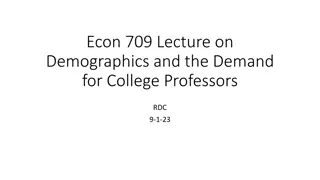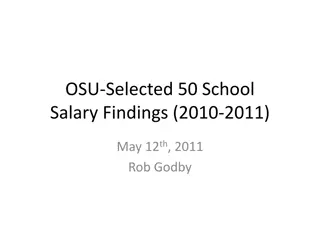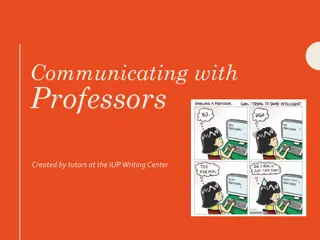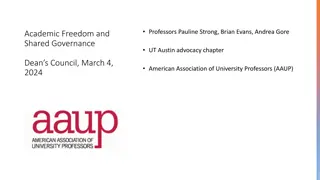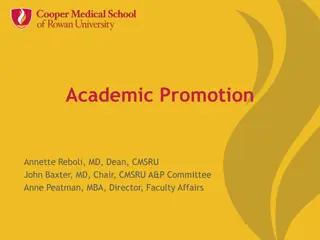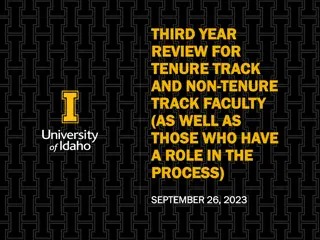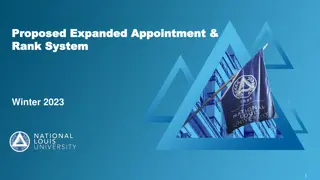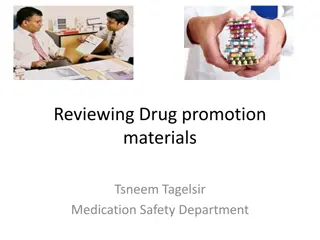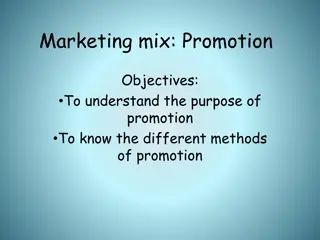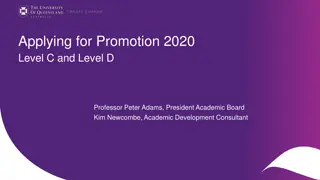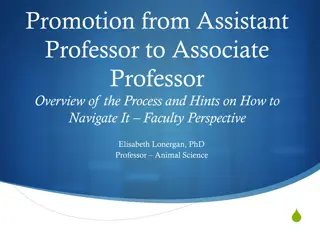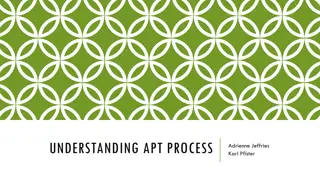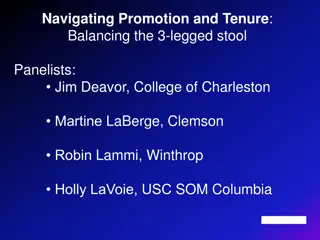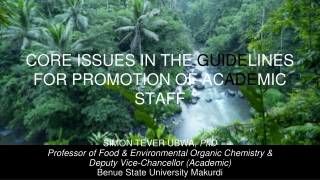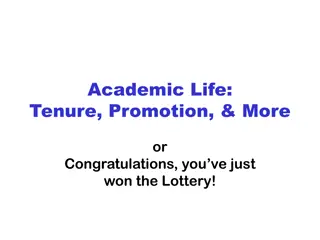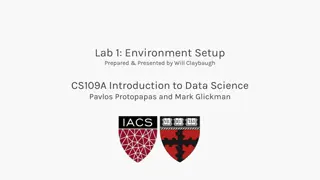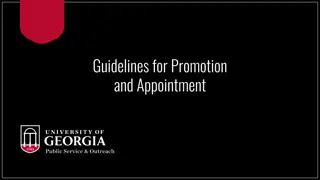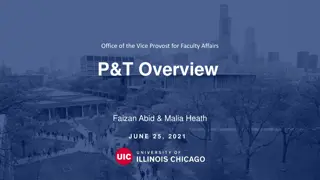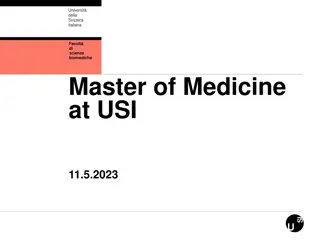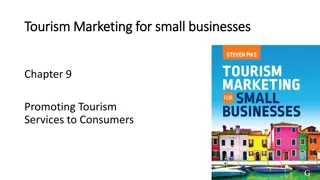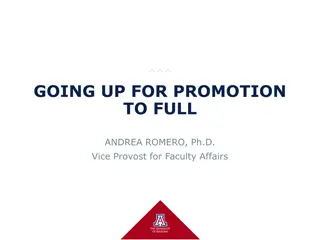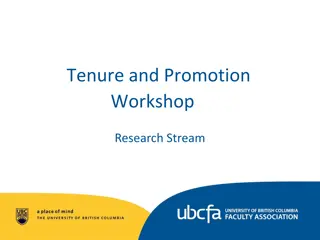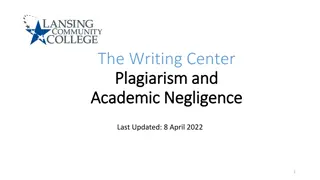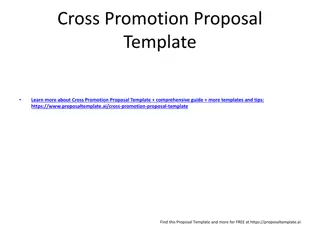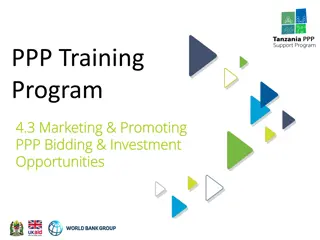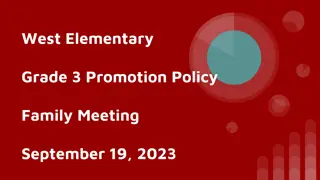Navigating the Promotion Path: Insights for Aspiring Professors in Academic Settings
The journey from Associate Professor to Professor is a significant milestone in an academic career. This content delves into the responsibilities of academic administrators in building strong academic units, the criteria for promotion to full professorship, the importance of sustained excellence in education and scholarship, and the impact of COVID-19 on faculty evaluation. It highlights the rigorous standards, evaluation processes, and average time in rank for promotions. Additionally, it emphasizes the critical role of reflective essays and offers insights from deans, chairs, and tenure committee members.
Download Presentation

Please find below an Image/Link to download the presentation.
The content on the website is provided AS IS for your information and personal use only. It may not be sold, licensed, or shared on other websites without obtaining consent from the author. Download presentation by click this link. If you encounter any issues during the download, it is possible that the publisher has removed the file from their server.
E N D
Presentation Transcript
FROM ASSOCIATE PROFESSOR TO PROFESSOR Agenda The View from the Provost Level Role of the Reflective Essay Navigating the Mid-Career Faculty Terrain Options and Opportunities for Development What do Deans, Chairs and College Tenure Committee Members have to say
APPOINTMENT, REAPPOINTMENT, TENURE, AND PROMOTION RECOMMENDATIONS academic administrators have the special obligation to build academic units strong in scholarship, teaching capacity, and public service. To discharge this responsibility, academic administrators must apply rigorous standards in making RPT recommendations. The achievement and performance level required must be competitive with faculties of leading research-intensive, land- grant universities of international scope.
Promotion to Full Professor A recommendation for promotion from associate professor to professor in the tenure system should be based on several years of sustained, outstanding achievements in education and scholarship across the mission, consistent with performance levels expected at peer universities
Promotion to Full Professor (1 of 2) Bearing in mind the University's continuing objective to improve its faculty, the unit and college must refrain from doubtful recommendations. The dean must evaluate carefully each recommendation to ensure that it is well grounded and fully justified.
Promotion to Full Professor (2 of 2) A reasonably long period in rank before promotion is usually necessary to provide a basis in actual performance to permit endorsement of the individual as an expert of national stature and to predict continuous, long-term, high-quality professional achievement.
Average Time in Rank When Promoted to Professor 10 9 8 7 6 5 4 3 2 1 0 2008 2009 2010 2011 2012 2013 2014 2015 2016 2017 2018
Evaluation & Impact of COVID COVID Impact statement - The purpose is to acknowledge that faculty and academic staff (FAS) at MSU have encountered varied challenges due to the pandemic. Guidelines for FAS on writing a COVID-19 impact statement that may be submitted to their unit administrator as part of their activity report for annual review, and to internal and external reviewers upon promotion appointment assessments. Prompts for considering what to include in the impact statement.
How to Use a COVID Impact Statement (1 of 3) Broad discussions within disciplines and academic units need to be facilitated to explore how the discipline(s) has been impacted by the pandemic and what opportunities for program growth and scholarship were not possible to inform the context of how to judge accomplishments. The impact statement provided by a FAS member is accepted as valid because they are a trusted member of the scholarly community. Each impact statement is equally valued .
How to Use a COVID Impact Statement (2 of 3) Impact of the pandemic may be accelerating as well as decelerating and may change over time. Under such extraordinary times, the work that is produced can still be evaluated based on quality and relevance to increasing knowledge and understanding rather than on quantity of work. Assessments about annual reviews, reappointment, and promotion must be made on the information provided by the FAS member. While a COVID impact statement is not required, impact that is not documented cannot be considered in assessments.
How to Use a COVID Impact Statement (3 of 3) Value-based categories like sharing information, expanding opportunities of others, and mentoring/stewardship may be applied to activity reports and impact statements to allow FAS to share the multiple ways learning, teaching, and knowing have occurred to indicate how FAS have been doing valuable, adaptive, human-based work in other new and perhaps non- traditional ways.
THE REVIEW PROCESS Department level committee makes recommendation to chair or school director Chair independently makes a recommendation to the dean The dean is advised by a college review committee The dean independently makes a recommendation to the provost
THE REVIEW PROCESS (Continued) Representatives of the provost meet with each dean Associate Provost AHR, VPRGS, and a distinguished MSU faculty member -- to review each case Provost meets with representatives and formulates recommendations for President and Board of Trustees 12
Please feel free to reach out to the Academic Human Resources team: Suzanne Lang langsu@msu.edu Kathy Lewless lewlessk@msu.edu Melissa Sortman sortmanm@msu.edu Jennie Yelvington petrovi8@msu.edu Kara Yermak burtkara@msu.edu


